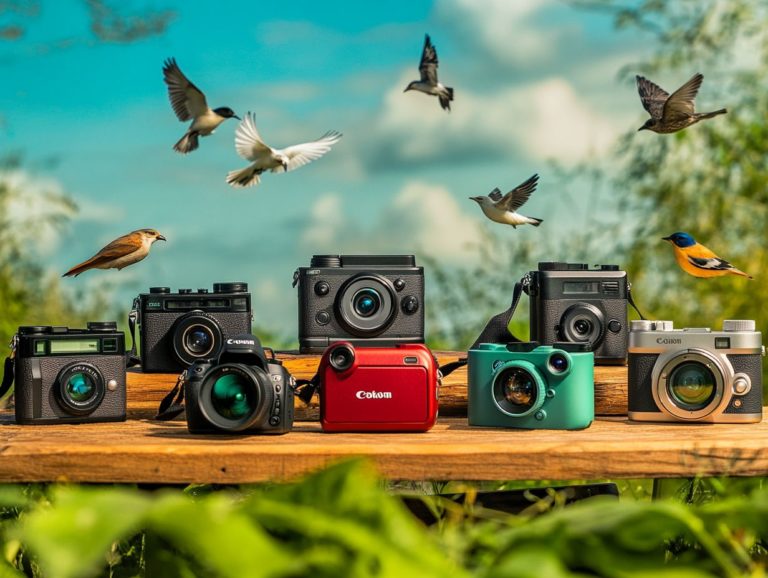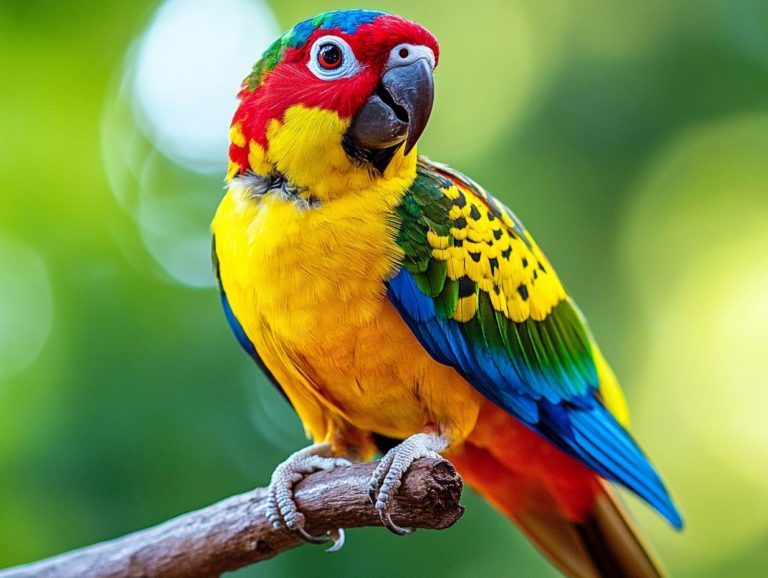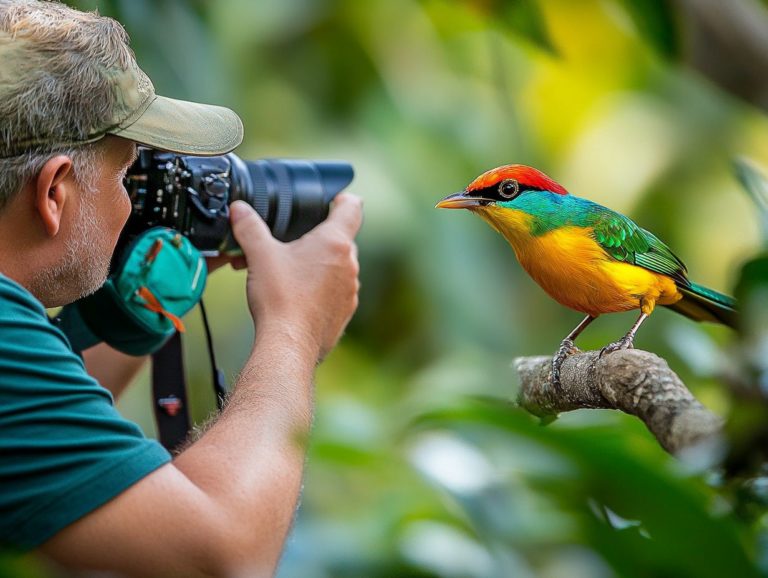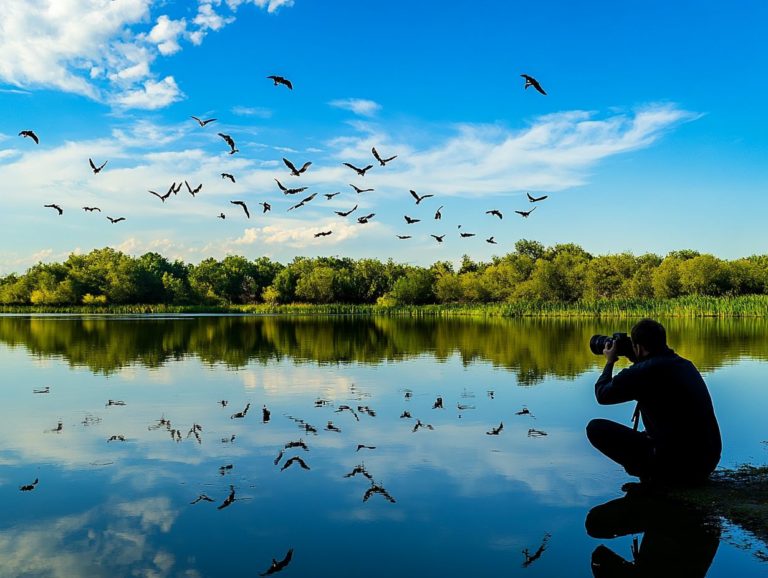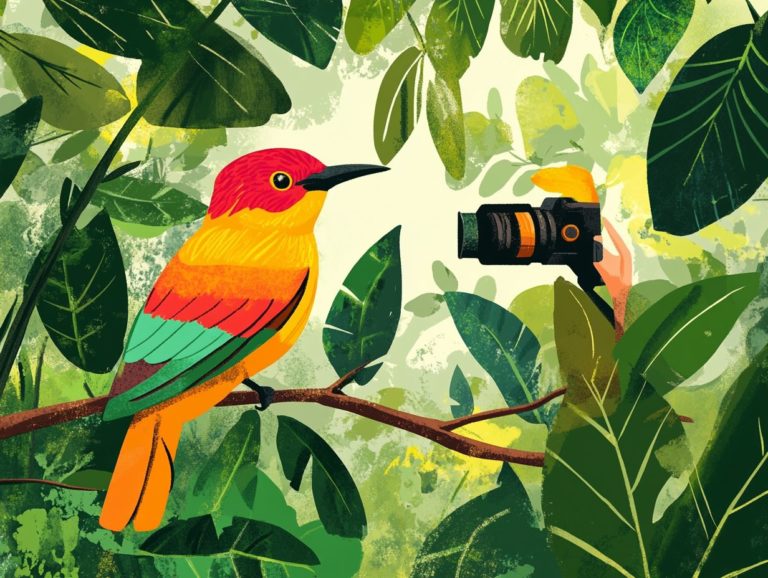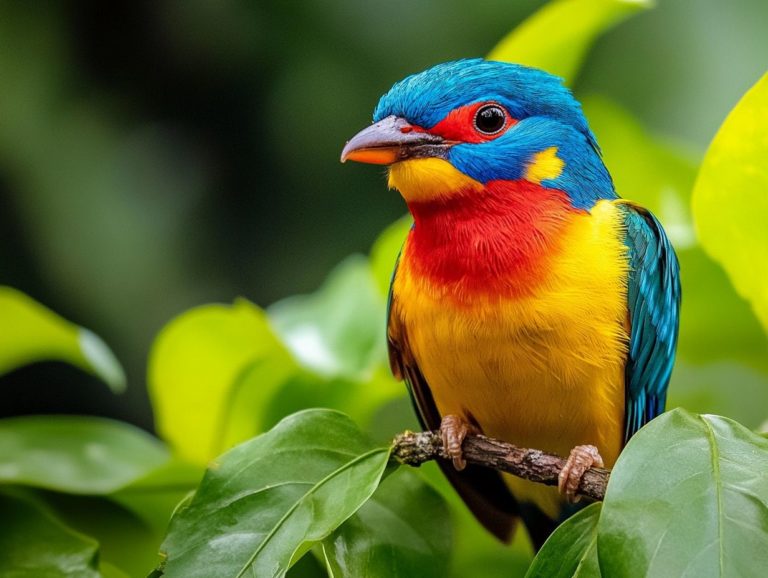Essential Lenses for Capturing Birds
Birdwatching and wildlife photography present an exhilarating opportunity to connect with nature. However, capturing those fleeting moments demands the right tools.
Investing in essential lenses can significantly enhance your bird photography experience. Each lens boasts unique features designed specifically for avian enthusiasts, allowing you to zoom in on distant subjects and capture intricate details up close.
Whether your goal is to create breathtaking portraits or expansive landscapes, exploring the ideal lens will elevate your photographic journey and breathe life into your birdwatching adventures.
Contents
- Key Takeaways:
- Telephoto Lenses: Capture Distance Like Never Before!
- Super Telephoto Lenses: Reach New Heights!
- Macro Lenses: Discover the Details!
- 4. Wide Angle Lens
- 5. Prime Lens
- 6. Zoom Lens
- 7. Tilt-Shift Lens
- 8. Mirror Lens
- 9. Teleconverter Lens
- 10. Fisheye Lens
- 11. Telephoto Zoom Lens
- 12. Standard Lens
- 13. Portrait Lens
- 14. Sports Lens
- 15. Landscape Lens
- Frequently Asked Questions
- What are the essential lenses for capturing birds?
- Do I need a special lens for bird photography?
- What is the best lens distance for capturing birds?
- Can I use a zoom lens for bird photography?
- Is a tripod necessary for bird photography?
- Are there any other lenses that can be useful for bird photography?
Key Takeaways:
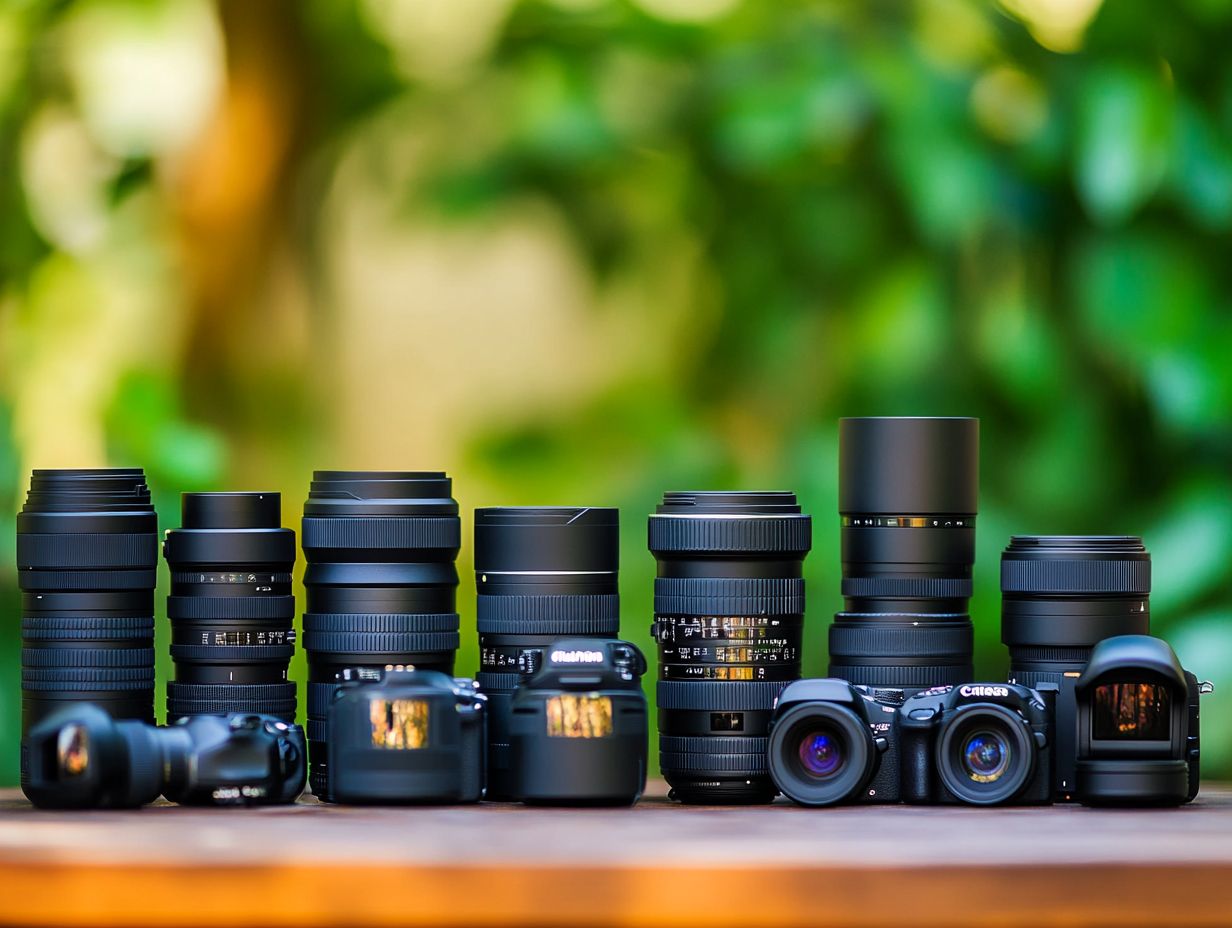
- Telephoto lenses are essential for capturing distant birds with sharp clarity and detail.
- Super telephoto lenses offer even greater magnification and are ideal for shooting birds in flight or perched on tall trees.
- Macro lenses are perfect for close-up shots of small birds and their intricate details.
Telephoto Lenses: Capture Distance Like Never Before!
If you want to capture breathtaking wildlife photos, telephoto lenses are a must-have! These remarkable tools provide an unmatched reach and versatility for capturing birds in flight. For those serious about bird photography, using high-quality binoculars can enhance your experience. Whether you’re an amateur or a seasoned pro, lenses like the 300mm f/4 and the Nikon 200-400mm offer excellent autofocus and depth of field, making them vital for nabbing elusive subjects in nature, especially in wildlife-rich areas like Alaska.
Typically, telephoto lenses boast long focal lengths, starting at 200mm and extending beyond 600mm. This allows you to frame your subjects without encroaching on their space, crucial for photographing skittish species like seabirds or other quick movers.
Moreover, these lenses excel at achieving a shallow depth of field, beautifully isolating your subject from the background. For instance, a 300mm f/4 lens can create a stunning blur around the subject while keeping it crisp and in focus.
Popular models like the Nikon 100-400mm provide added versatility with a zoom feature. This lets you swiftly adjust your framing as wildlife moves unpredictably, enriching your portfolio with a diverse range of images from close-ups of birds mid-flight to wide-angle captures of expansive habitats.
Super Telephoto Lenses: Reach New Heights!
Super telephoto lenses, such as the Sony 200-600mm and Nikon 200-400mm, are crafted for serious wildlife photographers. If you seek extreme reach to capture stunning images of birds in flight or other distant creatures, these lenses are essential!
Equipped with advanced features, they perform excellently in challenging environments. With image stabilization technology, even the slightest movements won t compromise your shots, ensuring sharp images of elusive subjects. Their impressive autofocus performance makes tracking fast-moving animals like eagles soaring majestically against the Alaskan sky much more manageable.
The wide maximum aperture enhances your low-light shooting capabilities. This is vital for early morning or late evening excursions when wildlife is most active. Whether you re capturing the intricate details of a feathered raptor or the swift movements of a running deer, these lenses promise exceptional clarity and focus.
Macro Lenses: Discover the Details!
Macro lenses are your gateway to capturing the intricate details of small subjects. They are ideal for close-up photography of flowers and insects, but also reveal the unique beauty of wildlife. These lenses uncover details that often elude traditional photography.
With macro lenses, you can delve into nature s microcosm. Capture vibrant patterns on a butterfly’s wings or the delicate textures of a frog’s skin. Using techniques like a shallow depth of field draws attention to your subject while softly blurring the background, creating a stunning contrast that highlights the subject’s features.
Consider the incredible opportunities presented by creatures like dragonflies, beetles, and even tiny mammals such as shrews. Each capture not only celebrates the natural world but also weaves an unseen narrative, inviting viewers to appreciate the beauty found in the small details that surround us.
4. Wide Angle Lens
Wide angle lenses are essential for photographers aiming to capture vast landscapes or striking wildlife shots. They offer a broader perspective that enhances the beauty of nature while providing context for your subjects.
Utilizing these lenses allows you to include a sweeping backdrop that showcases the habitat where animals thrive. For example, when photographing herds of caribou in Alaska, a wide angle lens enables you to frame the majestic mountains and expansive tundra, transforming a simple shot into a captivating story about their migration.
To masterfully compose such images, position yourself at a lower angle. This technique not only highlights the animals but also brings their beautiful surroundings to life! Experimenting with leading lines, like riverbanks or trails, can effectively guide viewers’ eyes through the image, immersing them in the scene you ve captured.
5. Prime Lens
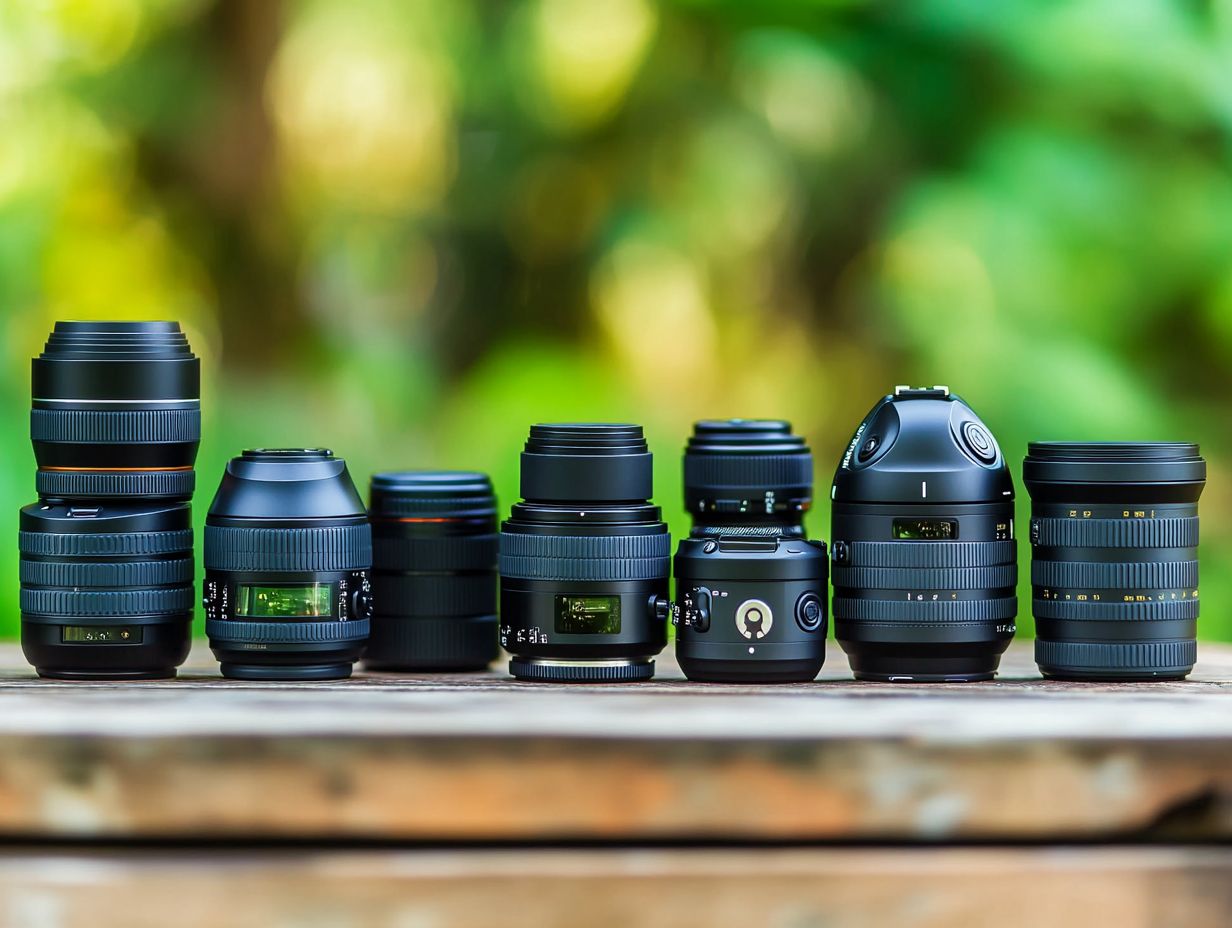
Prime lenses, with their fixed focal lengths, provide exceptional image quality and wide apertures. This makes them a top choice for wildlife photographers who value sharpness and depth of field in their images.
This unique advantage benefits photographers, especially in low-light scenarios, such as the early morning or twilight hours, where prime lenses truly shine. They help you capture breathtaking images of elusive wildlife while keeping noise to a minimum. The stunning bokeh your subject appearing sharp against a beautifully blurred background enhances the focus on intricate details of animals, like a bird, during a fleeting moment in nature.
Popular options like the 300mm f/2.8 or the 50mm f/1.8 excel in various settings from capturing the vibrant plumage of a kingfisher perched on a branch to freezing the action of a cheetah sprinting across the savannah. Are you ready to elevate your wildlife photography with a prime lens?
6. Zoom Lens
Zoom lenses provide remarkable versatility in wildlife photography, enabling you to swiftly adjust focal lengths to capture a range of subjects, whether it’s birds soaring overhead or animals lurking in the distance.
This adaptability proves invaluable in unpredictable environments where subjects might suddenly make an appearance or dart away. Lightweight zoom lenses, like the Canon 100-400mm, enhance your experience by striking a perfect balance between performance and portability.
Equipped with features such as image stabilization which reduces blur from camera shake and weather sealing, these lenses are perfect for your next outdoor adventure don’t miss out! You can effortlessly shift from wide-angle shots of breathtaking landscapes to intimate close-ups of elusive wildlife, crafting a rich and diverse portfolio without the hassle of cumbersome gear. This convenience allows you to seize spontaneous moments, elevating your overall photography experience.
7. Tilt-Shift Lens
Tilt-shift lenses offer excellent control over how you see your subjects, granting you the ability to make creative adjustments that elevate both landscape and wildlife photography.
With the remarkable ability to tilt and shift, these lenses unlock a world of creative possibilities. In landscape photography, you can manipulate the plane of focus to craft striking images that direct the viewer s gaze to specific details, creating a captivating miniature effect reminiscent of dioramas.
In wildlife settings, these lenses allow you to isolate your subject from distracting backgrounds, expertly managing depth of field. This technique highlights the majesty of the animal while ensuring that the surrounding scenery enhances rather than competes with it.
By enabling adjustments in perspective, tilt-shift lenses can correct convergence issues in towering trees or mountains. They are essential for capturing nature’s beauty in a coherent and breathtaking manner.
8. Mirror Lens
Mirror lenses, often called mirror lenses, are celebrated for their compact design and long focal lengths. They are a great choice for wildlife photographers seeking to capture distant subjects.
Their lightweight nature lets you maneuver easily in the field, reducing the burden of heavy gear. You ll also notice their optical qualities create a unique bokeh, adding flair to your wildlife images.
However, be aware of the fixed aperture, which can limit your shooting in different lighting conditions. But don t let that hold you back mirror lenses excel in bright environments, like open fields or during daylight hours, making it simple to photograph fast-moving animals.
For instance, capturing birds in flight or spotting elusive mammals becomes seamless with these compact tools.
9. Teleconverter Lens
Teleconverter lenses are essential tools for wildlife photographers, as they extend the effective focal length of your existing lenses without a significant loss in image quality.
By attaching a teleconverter, you can transform a standard telephoto lens into a powerful instrument, making it easier to capture stunning images of distant animals in their natural environments. For example, a 1.4x teleconverter converts your 200mm lens into a powerful 280mm lens, enhancing your zoom capabilities without disturbing wildlife.
This feature is especially useful when your subjects like birds in flight or elusive mammals require extra reach. In low-light scenarios, it s crucial, allowing you to maintain fast shutter speeds while achieving that sought-after shallow depth of field.
10. Fisheye Lens
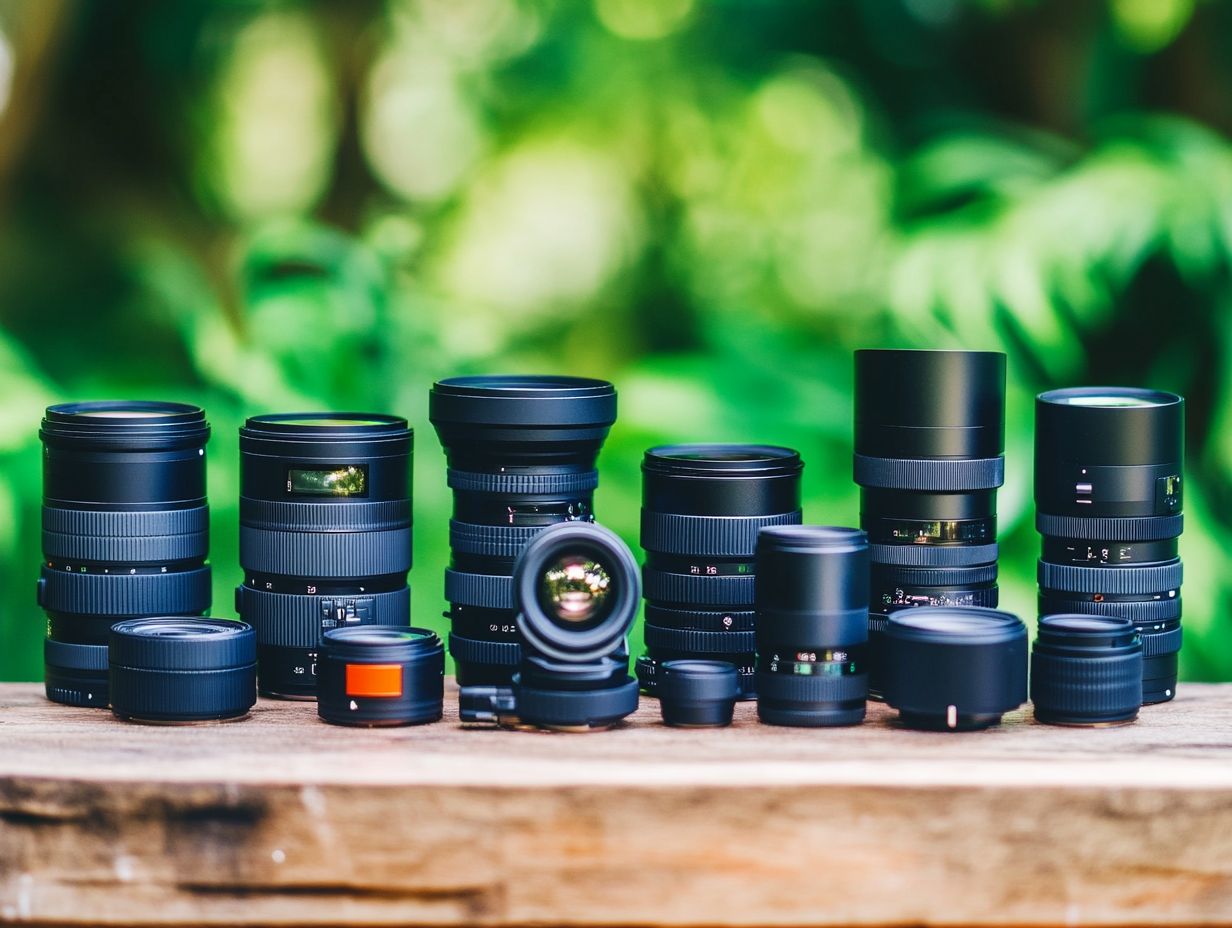
Fisheye lenses offer a unique perspective that creatively distorts images, perfect for innovative wildlife photography that captures subjects in unexpected ways.
These lenses also let you capture expansive landscapes while ensuring your animal subjects steal the show, enhancing depth and context. Picture framing a playful otter diving into a river, set against a stunning backdrop of dense forest. The result? An immersive scene that pulls you in as a viewer!
Now, imagine capturing a herd of elephants against a sprawling savannah with a fisheye lens. Not only does it highlight their impressive size, but it also offers a dynamic view of their natural habitat. By manipulating the horizon’s curvature, these unique shots draw you into the animals’ world, making wildlife interactions unforgettable.
11. Telephoto Zoom Lens
Telephoto zoom lenses are essential for wildlife photographers, offering the versatility to capture action shots of birds and animals without needing to swap out lenses constantly.
These lenses provide an impressive range of focal lengths, allowing you to zoom in on subjects while keeping a respectful distance crucial to not disturb the wildlife. For those interested in capturing stunning images, consider exploring tips for choosing binoculars for bird photography. With remarkable image quality, these tools ensure every detail remains sharp, from the vibrant plumage of a hummingbird to the intricate patterns on a deer’s coat.
Modern telephoto zoom lenses also feature excellent autofocus performance, enabling you to quickly focus on moving subjects. Popular choices like the Canon EF 100-400mm f/4.5-5.6L IS II and Nikon Z 100-400mm f/4.5-5.6 VR S excel in bird photography, making them go-to options for professionals eager to capture fleeting moments in nature with clarity and precision.
12. Standard Lens
Standard lenses are versatile allies in wildlife photography, offering a natural perspective that frames animals beautifully within their environments. This type of lens captures intimate moments, showcasing intricate details of animal behavior. Whether you capture a deer grazing in a sun-drenched meadow or a bird building its nest amid vibrant foliage, understanding the role of filters in bird photography can enhance your images. By getting closer to your subjects, you create images that foster a relatable and immersive narrative about wildlife’s habitat.
A wide shot with a standard lens can reveal how rabbits interact with their surroundings, providing insights into their natural behavior and the ecosystem that sustains them. These lenses give you the chance to blend foreground and background elements, enriching the storytelling aspect of each photograph.
13. Portrait Lens
Portrait lenses, celebrated for crafting stunning, creamy backgrounds, are your secret weapon in wildlife photography. Capture the essence of animals in controlled environments or during rare close encounters.
With wide apertures, these lenses create a shallow depth of field, effectively isolating your subject from its surroundings. This technique draws the viewer s gaze directly to the animal, whether it s a majestic eagle perched gracefully on a branch or a curious fox peering through the underbrush.
The natural compression of these lenses yields breathtaking environmental portraits, showcasing the animal within its landscape while maintaining sharp focus. Capture a lion lounging in tall grass with a portrait lens to evoke a profound sense of closeness and connection, allowing viewers to appreciate the beauty of the wild.
14. Sports Lens
Sports lenses are crafted for speed and precision, making them ideal for capturing fast-moving wildlife in action. For enthusiasts, understanding the benefits of using a prime lens for birding can enhance your experience, whether it’s birds soaring through the sky or animals during dynamic moments.
These specialized lenses come with automatic focusing systems that quickly adjust to your subject, ensuring rapid and accurate focusing, even when they dart across the frame. Superior image stabilization technology allows you to shoot handheld without losing sharpness, even in challenging conditions.
Capture stunning moments of an eagle swooping down for its prey. Sports lenses provide the clarity and detail needed to transform fleeting moments into breathtaking images. Additionally, using must-have accessories for bird photography elevates your wildlife photography and caters to your enthusiasm for documenting the energetic natural world.
15. Landscape Lens
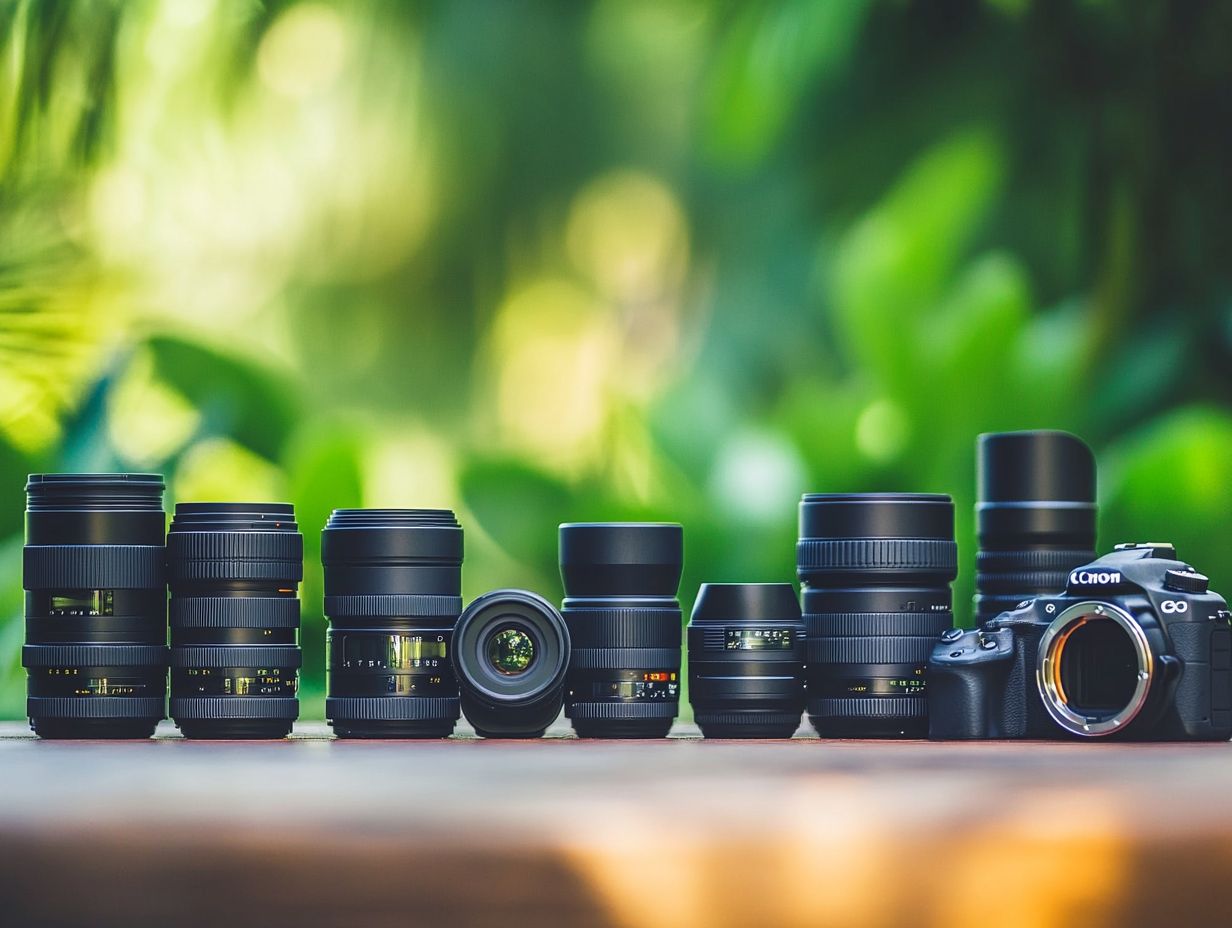
Landscape lenses are ideal for capturing the vastness of nature. When paired with wildlife subjects, they create breathtaking compositions that celebrate both the scenery and its vibrant inhabitants.
Embrace these lenses to strike a captivating balance between sweeping horizons and the intricate details of wildlife. Use the rule of thirds while composing your shots; this technique guides the viewer’s eye throughout the image, accentuating the interplay between the landscape and its living elements.
Position animals at one of the intersecting points to create dynamic tension that underscores their significance within the scene. Experiment with depth of field to enhance the relationship between foreground and background, allowing wildlife to emerge organically from the stunning backdrop, enriching your photograph’s narrative.
Frequently Asked Questions
What are the essential lenses for capturing birds?
The essential lenses for capturing birds include:
- Telephoto lenses with a focal length of at least 300mm
- Macro lenses for close-up shots
- Wide-angle lenses for capturing birds in their natural habitat
Do I need a special lens for bird photography?
Yes, you need specialized lenses with long focal lengths to capture birds in their natural habitat without disturbing them, and exploring photography gear essentials for birdwatching can help you make the right choices.
So, grab your gear and head out to explore the world of wildlife photography with these essential lenses!
What is the best lens distance for capturing birds?
The best lens distance for capturing birds is usually 300mm or longer. This distance helps you avoid scaring them away, and using the right techniques for photographing birds in flight can enhance your results even further.
Can I use a zoom lens for bird photography?
Yes, a zoom lens is great for bird photography if it has at least 300mm distance. However, prime lenses are often sharper and preferred by many photographers.
Is a tripod necessary for bird photography?
A tripod is a fantastic tool for capturing stunning bird photos! It stabilizes your camera, especially with heavier lenses, preventing blurriness.
Are there any other lenses that can be useful for bird photography?
Besides telephoto and macro lenses, a teleconverter can be useful for bird photography. It extends the lens distance, letting you capture birds from farther away.

